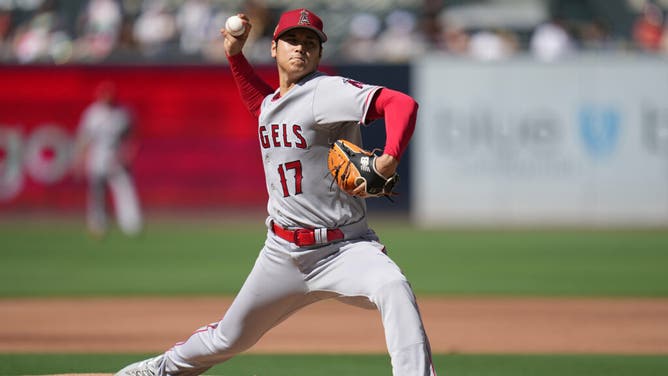ANALYSIS: What Does Shohei Ohtani Signing Mean For Baseball?
Shohei Ohtani announced on Saturday that he’s joining the Los Angeles Dodgers, putting an end to one of the most bizarre and fascinating free agency processes the sport’s ever seen.
Almost immediately, the Angels began pulling down the large mural of Ohtani at Angel Stadium in Anaheim.
But Saturday’s news is a monumental day not just for the Angels, who lose one of the best players in baseball history to their neighbors up north, but for the sport as a whole. And there are three major components to his decision that have the potential to fundamentally change the future of Major League Baseball.

SAN DIEGO - Angels starting pitcher Shohei Ohtani throws a pitch against the Los Angeles Dodgers on July 4 at Petco Park. Credit: Ray Acevedo-USA TODAY Sports
Shohei Ohtani Sets New Precedent For Sports Contracts
First and foremost, Ohtani has entirely reframed the expectations for individual player contracts in major domestic sports leagues.
The 10-year, $700 million figure is awe-inspiring, astronomical, unheard of, jaw dropping. All of the above, and then some. The valuations of entire baseball teams just a few years ago hovered around $700 million. Guggenheim Partners purchased the Dodgers in 2012 for $2 billion. Ohtani by himself just got $700 million.
Even in the latest Forbes estimate of franchise valuations, the 30th-ranked Miami Marlins came in at $1 billion. Shohei Ohtani is apparently worth 70 percent of the entire Marlins organization.
It’s not just the sheer size and scale of the deal that’s unprecedented; it’s the deferrals too. While the full details haven’t yet been revealed, initial reports suggested that “most” of his yearly salary would be deferred. There have been long-term deferrals in the past, but could the future number reach $250 million? $300? $350 million?
Ohtani suggested that structure to the Dodgers, according to his agent, in order to ensure the Dodgers could stay competitive within the confines of the luxury tax. But the total dollar figure is reframing what’s possible for players to earn. Scott Boras is already dreaming of what he’s going to get out of Steve Cohen for Juan Soto next fall.
Marketing Madness For MLB
The Dodgers likely don’t care about the cost for Ohtani because of the ancillary value he provides. No other star in the game is capable of commanding the attention and marketing Ohtani generates.
For the first six years of his career, he’s toiled in relative obscurity in Anaheim. Despite also rostering Mike Trout, the Angels were never really competitive during Ohtani’s tenure. A mix of bad luck, poor free agent signings, a lack of organizational development and underperformance meant they never won more than 80 games with him on the team.
Now he moves to a team that’s made the postseason every season since 2013. The Dodgers have won more than 100 games each of the past four full seasons and five of the past six. In 2020, their 60-game pace was that of a 116-win team. Given the expanded postseason format, the Dodgers’ postseason odds now are likely above 95 percent.
Finally, the game’s biggest player will play on the game’s most consistently good team. After a record-low rated World Series in 2023, MLB must be thrilled they’ll be able to market a pennant race and postseason with Ohtani in it. Merchandise, ratings, and most importantly, interest from casual fans or those who previously didn’t follow baseball.
Just look at what Lionel Messi and Deion Sanders meant to their sports this year. Fans want to watch stars, and Shohei Ohtani is the biggest star.
Shohei Ohtani’s Impact On The Field
Those financial details and off field opportunities exist because of Ohtani’s on-field performance. And the Dodgers are suddenly neck-and-neck with the New York Yankees as favorites to win the World Series.
Except, as we know, the regular season conclusively doesn’t matter when we get to October. Effectively, the Dodgers World Series probability barely moved, despite signing one of the best players in baseball history. Welcome to the era of a meaningless 162-game season.
But all teams can do is put themselves in the best possible position heading into the playoffs. And the Dodgers have most certainly done that. For this season, and the next few at the very least. Facing Ohtani, Mookie Betts and Freddie Freeman four times a game isn’t a pleasant thought for any opposing team. And that’s before accounting for Ohtani's expected 2025 return to the mound.
There’s plenty of reason for optimism in Los Angeles now, even though the Dodgers' rotation needs work. To put it mildly.
So What Does All This Mean?
Overall, this is a good thing for baseball. It shows the sport is in a remarkably healthy financial position, even after the 2020 shutdowns.
It makes MLB's media rights more valuable, both in the regular season and the postseason. It’ll undoubtedly raise the profile of the sport in its competition with the other leagues. The Dodgers franchise valuation rises, which means the rest of the teams also see their valuations rise. It’s all good.
Except, similarly to how the Soto trade showed that small market teams can’t fundamentally break out of their market size, the dollar figure involved reinforces that fans of teams like the Pirates, Royals or Rays can never expect to lockdown one of the game’s biggest stars.
If anything, it’ll likely exacerbate teams’ efforts to sign young prospects to long term extensions before they debut. Just like the Brewers and Jackson Chourio. The Orioles will surely try with Gunnar Henderson, Jackson Holliday and Grayson Rodriguez. It’s great for the sport as a whole, but also bad for some of its teams.
That said, imagine a Dodgers-Yankees World Series in 2024. Or the inter-division battles between Betts, Freeman and Ohtani vs. Machado, Tatis and Bogaerts. There’s a lot to get excited about for the future of baseball. Especially if you’re a Dodgers fan.